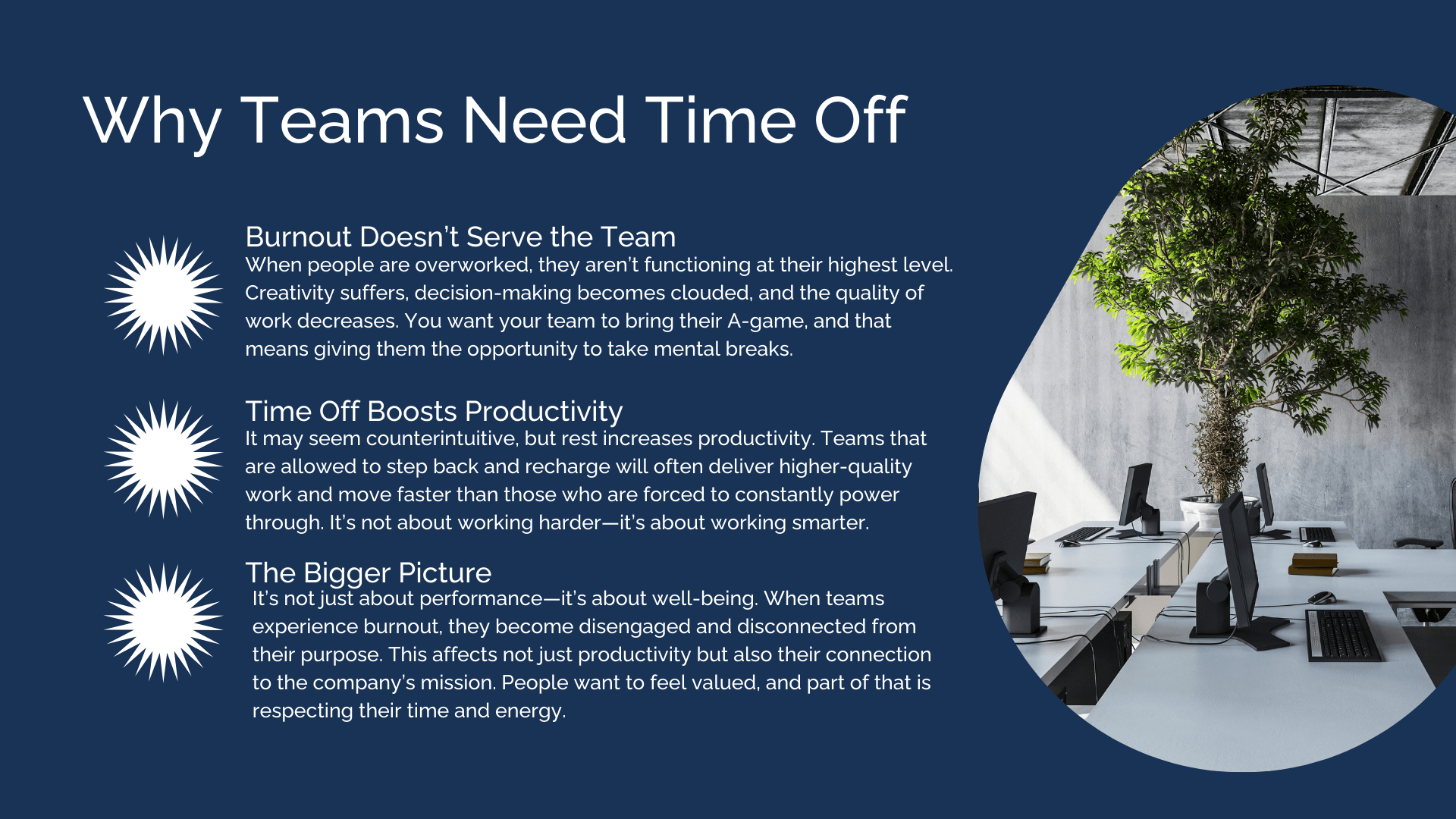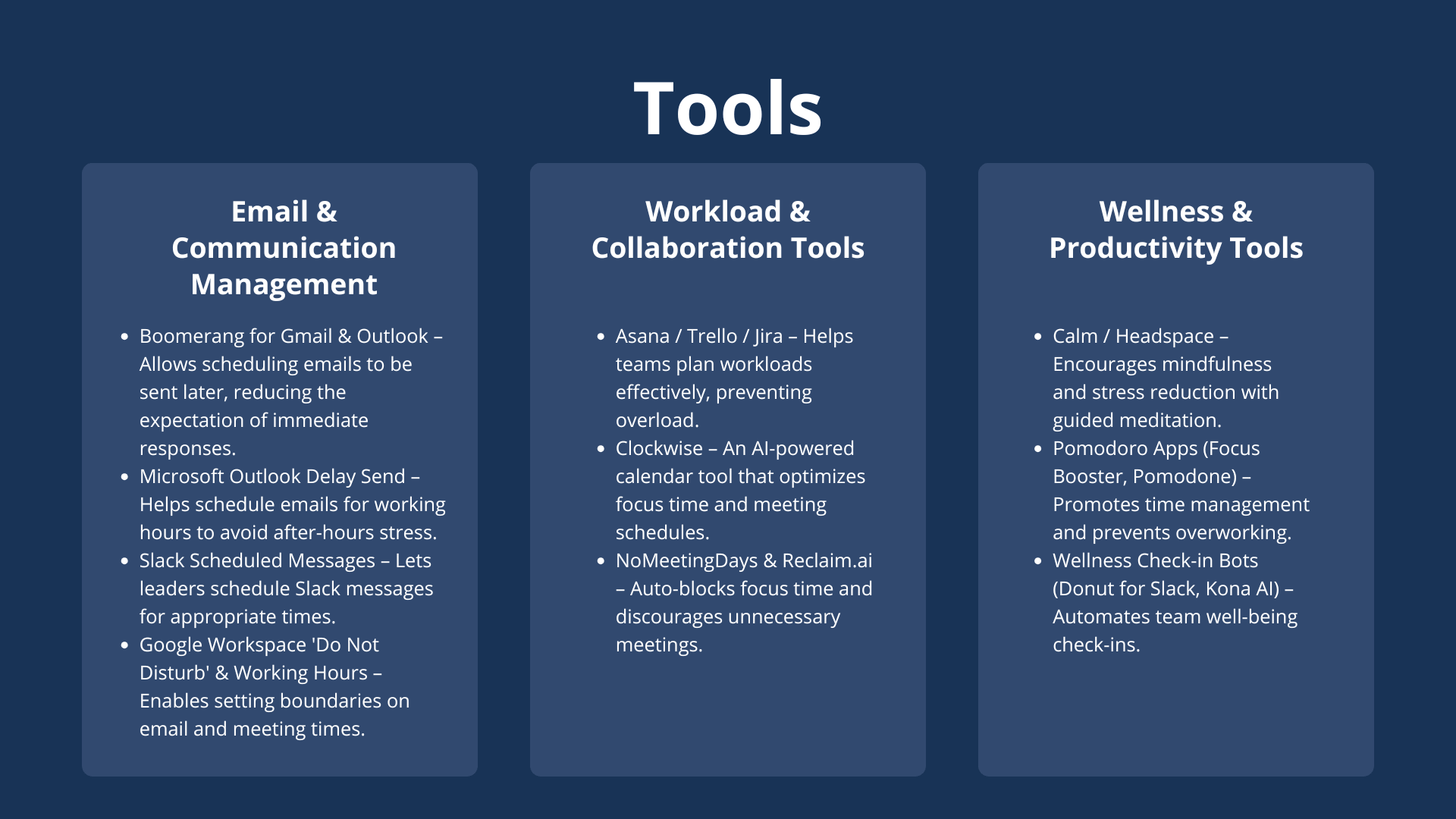When was the last time you felt truly heard? Not judged, fixed, or interrupted but to have somebody just be with you in your experience? To hold space for you while you spoke, without rushing to offer advice or steer the conversation in another direction? To be heard not just for your words, but for the truth behind them?
Nowadays, these moments are rare. We have normalized a type of listening that isn’t really listening at all.
We listen for our turn to speak.
We listen to reply, rather than understand.
We listen to offer solutions while someone is still describing their situation.
We listen through the filter of our own experiences and biases.
We listen to judge, correct, or insert our opinions.
In personal development there is a distinction regarding how people listen to others, you can think of them as filters, often distorted, that we pick up from our experiences as we grow. Everything we already "know to be true" makes up our permanent state of listening. We think we are open-minded, but we listen to people through a wall of our opinions; judging, condemning, wanting to reply, instead of being present to what they are saying. Our pre-existing opinions, stories and judgments hinder genuine understanding. By taking the time to recognize this tendency in ourselves, becoming aware of our filters and pushing them to one side while we listen to others, it allows for more authentic and effective communication.
What we rarely do is listen to learn. To understand. To hold space for someone. To hear them for who they are and what they are going through.
Yet, when you hold space for someone and actively listen when you are fully present with them and their words you create something powerful. This kind of listening allows people to move through grief, gain profound insight, and rediscover meaning in their own words. Simply being heard can be transformative. As leaders, it is integral for us to learn how to listen in this way. Gold drops out of people's mouths when you do.
The 3 biggest listening traps:
The "Me Too" Trap - You relate everything to your own experience.
Example: Someone shares a tough challenge, and instead of fully hearing them, you jump in with, “That happened to me too! Here’s what I did…”
❌ Why it’s a trap: It shifts the focus to you instead of validating them.
Example: Someone shares a tough challenge, and instead of fully hearing them, you jump in with, “That happened to me too! Here’s what I did…”
❌ Why it’s a trap: It shifts the focus to you instead of validating them.
The "Fix It" Trap - You immediately try to solve the problem instead of listening.
Example: A friend vents about their stressful job, and you say, “You should just quit.”
❌ Why it’s a trap: Most people don’t want solutions—they want to feel heard first.
Example: A friend vents about their stressful job, and you say, “You should just quit.”
❌ Why it’s a trap: Most people don’t want solutions—they want to feel heard first.
The "Mind Reader" Trap - You assume you know what they mean without clarifying.
Example: Someone says, “I had a really tough day,” and you assume it’s work-related—but it’s actually personal.
❌ Why it’s a trap: Assumptions lead to misunderstandings and make people feel unheard.
Example: Someone says, “I had a really tough day,” and you assume it’s work-related—but it’s actually personal.
❌ Why it’s a trap: Assumptions lead to misunderstandings and make people feel unheard.
The Power of Active Listening
Active listening is the antidote to the half-hearted, distracted listening that dominates our conversations today. It requires full presence, deep curiosity, and a commitment to understanding the other person's perspective. Listening as an active process that creates the space for speaking and understanding: Listening is the clearing in which speaking can occur; it’s the possibility for understanding, for meaning, for being known and loved. It is to hold space for someone, which means creating an environment of presence, acceptance, and non-judgment where they feel safe to express themselves fully. It’s the act of deeply listening without trying to fix, advise, or control the outcome; allowing the other person to process their emotions, thoughts, or experiences in their own way. It is also an active choice for how you choose to listen to others. You can choose to listen to them through your opinions, e.g., "oh she is arrogant" and when you are in that space, that is all you will hear, but if you actually choose an empowering space to listen from such as, e.g., "gold drops out of her mouth when she speaks" only then will you be open enough to hear the gold.
Unlike passive listening, where we merely hear words and seek to reply, active listening ensures the speaker feels valued, understood, and acknowledged.
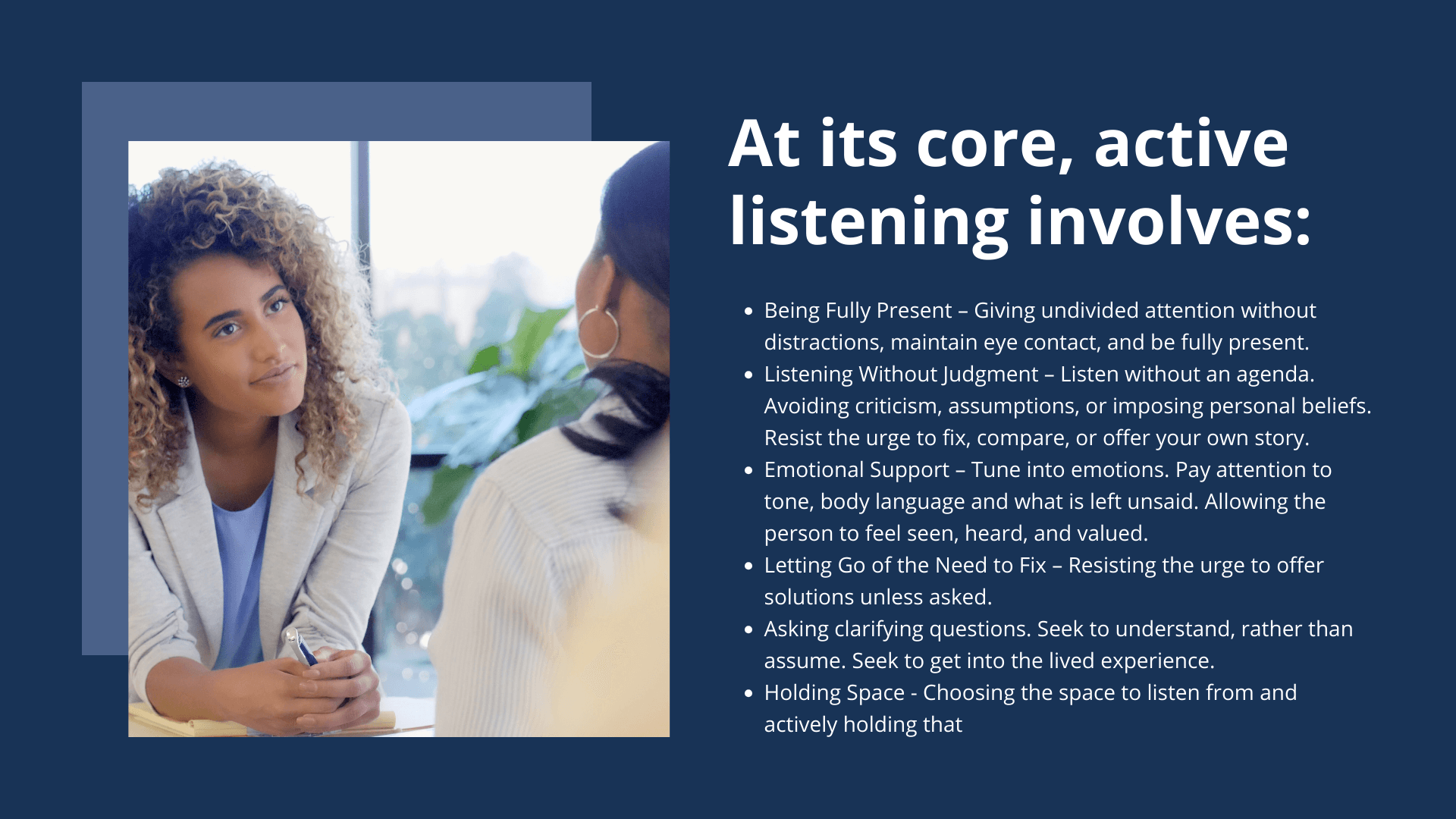
How to Practice Active Listening
- Be Present - Silence notifications, put your phone down, and shift your focus entirely to the person speaking. This signals that they have your undivided attention.
- Mirror Back - What You Hear Mirroring means repeating key words or phrases to show you are engaged. If someone says, you’ve been feeling overwhelmed with work lately, you might respond, “Overwhelmed with work?” This simple technique encourages the speaker to go deeper.
- Use Reflective Empathetic Listening - Go beyond just mirroring by paraphrasing what the speaker has said in your own words. For example: Speaker: feel stuck in my job, but I’m scared to make a change. Listener: It sounds like you’re feeling trapped, but also unsure about what comes next. Reflective listening helps the speaker feel truly heard and understood. Listen for the emotions through changes in tone, body language or speed of speaking. Listen for what is not being said, for what lies behind what is said.
- Clarify - Asking open-ended questions to gain deeper insight into the speaker's thoughts and feelings.
- Resist the Urge to Fix - Often, people don’t need solutions they need space to process their thoughts. Instead of jumping in with advice, ask, Do you want feedback, or do you just need to vent?
- Validate Their Experience - Acknowledge their emotions without judgment. Saying things like "That sounds really difficult" or "I can see why you’d feel that way" and create a safe space for honest conversation.
- Notice Biases, Opinions & Judgements - Forming opinions about the speaker or their message prematurely, which can create barriers to understanding. Focusing only on parts of the conversation that align with one's interests or biases. Put these to one side.
- Holding Space - choose an empowering stance to listen from - every morning I choose to listen to people as if "gold drops out of their mouths" and guess what? That is what happens. It is an empowering space for both them and me and it is an active practice.
The Transformative Power of Listening
This type of listening is simple, but not easy. It requires patience, self-awareness, creation and a willingness to set aside your own perspectives. But when you truly listen without interrupting, fixing, or filtering through your own lens you give the other person a rare and precious gift: the feeling of being seen and heard. By practicing these habits, leaders can work towards being more engaged and and having unbiased listening.
In a world where so many people are waiting for their turn to speak, be the person who listens to understand, to learn, to hold space. You might be surprised at how much it changes your relationships, your leadership, and even yourself.
Trust is the foundation of high-performing teams!
Without trust, collaboration suffers, innovation stalls, and engagement plummets. But trust isn’t built overnight and is cultivated through consistent actions, integrity, plus some structure and self-awareness.
In leadership, I believe that trust, or creating psychological safety, is twofold:
1. Vulnerability-Based Trust The ability to be open, admit mistakes, and create an environment where others feel safe to do the same. Being authentic and vulnerable is critical to this sort of trust and if you are in a leadership role, you have to role model it first, in order to create an environment where others feel safe enough to follow, especially if trust has been broken by others. Spending time with the team and getting to know them as fellow human beings is an essential part of this. Transactional relationships will not allow high performance to blossom over an extended period of time. As a leader you must be willing to foster deep relationships built over time, for high performance to occur. In other words you have to invest in people. Get to know them, coach them, learn about their inner lives, what they’re passionate about, what they hope to achieve, what they dislike and support them in achieving that, by being of service! Secondly, you have to allow yourself to be real, to be your authentic self; if you make a mistake or don't know, admit it, identify the learning and move on.
2. Operational-Based Trust The agreements, values, and structures that ensure fairness, accountability, and consistency in how the team operates. Have you sat down to identify a set of team agreements, based on collective values?? If you have a set of values identified; take that next step and break them out as a set of expected behaviours. Don't put them up on the wall and expect people to know them & understand them. Core values are fundamental values of an organisation, but really, they are about how work gets done, how people conduct themselves & how decisions get made and lastly, what do you expect of each other? So you really have to take the time to break values down as behaviours that address all of this. Without this, how would you expect to align? How do you know if something is the right thing to do as an organisation? How do you understand what is expected, where to go or what to do with big decisions, how to improve? How do you give feedback on work without these agreements identified and agreed upon? This is the very basis of culture, a set of agreements between you, which are based on values you all think are important, broken out as behaviours. We often miss this component of trust.
When both are present, teams thrive because of the clarity that comes from clear & explicit values & behaviours and the environment the supports risk & learning. When they’re absent, dysfunction creeps in.
Why Trust Matters in Leadership
Leaders set the emotional tone for their teams. If people trust their leader, and have psychological safety they:
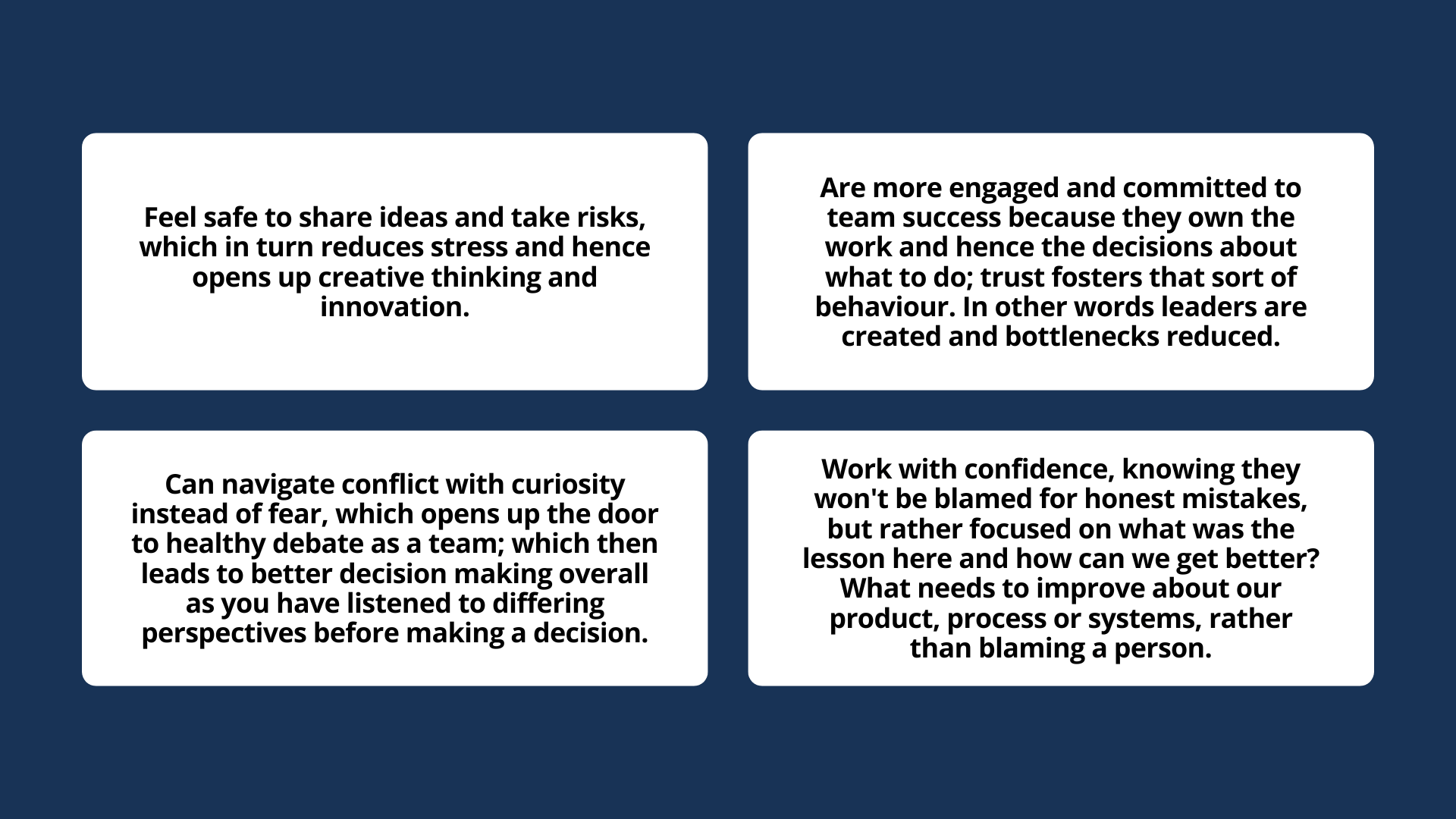
But when trust erodes, fear takes over. Team members may hesitate to speak up, withhold information, or even disengage entirely and the atmosphere will turn very negative and gossipy.
How to Build Vulnerability-Based Trust
Vulnerability in leadership doesn't mean oversharing or being overly emotional. It means:
- Admitting when you're wrong or don’t have all the answers
- Asking for feedback and acting on it
- Acknowledging your own learning curve and growth areas
- Creating space for open, judgment-free conversations
- Looking for the issues & problems in products, processes & systems, rather than blaming individuals
- Identifying when you didn't share enough context.
- Connecting as human beings over lunch, drinks or dinner and learning about each others lives on a regular basis
When leaders model vulnerability, they give permission for their teams to do the same fostering deeper connections and psychological safety, but be cautious, don't tailspin into drama and oversharing; always focus on being professional at work, no matter your role.
How to Build Operational-Based Trust
While vulnerability-based trust fosters openness, operational-based trust provides structure and predictability. Without clear team agreements and shared values, even the most well-intentioned teams can spiral into chaos.
To build operational-based trust:
- As a team, identify your key values & guiding principles; do this individually first and then collate together and identify your top 6-10 values that you are all aligned on.
- Break down those values into behaviours; what do you expect of each other for that value, what do they look like as day to day behaviours, e.g. integrity would be: do what you said you would be when you said you would do it, only say things that you would to a person's face, clean up & admit it when you make a mistake, are just some examples for integrity.
- Add this to a document that you will iterate on and share it with everyone so they can read the final version. Share it with all new onboarding staff and ask them to add to it and help shape it.
- As a leader, focus on having conversations that relate back to the doc regularly, keep them focused on it and their behaviour
- Give feedback to staff based on that doc; always working to align behaviour back to expectations. Also ask for feedback from them, based on the agreements. Where are you as a leader, falling short. These are bits of gold that you can gather for your own growth. Feedback is a gift for exponential growth. It is not a criticism, but an objective point of view; taking you out of your own subjectivity.
- Set Clear Expectations. Define team goals, roles, and responsibilities. Clarity removes ambiguity and minimizes frustration. You can do a ways of working workshop and analyze your roles & responsibilities with each others; what you think your job is, what others think the job is & the difference. Analyze your meetings & ceremonies while you are at it.
- Be Fair and Consistent. Treat people equitably, not just based on who you like or who speaks the loudest. Be very conscious of your own biases.
When teams operate within shared agreements and values, trust becomes embedded in the culture not just dependent on individual relationships.
Toxic Leadership: The Silent Trust Killer
Toxic leadership is a pattern of behavior that harms people and the organization Toxic leaders can be insecure, narcissistic, or incompetent, and they may lack empathy or confidence. They can create a culture of fear and mistrust, where employees are afraid to speak up. While most leaders don't set out to be toxic, certain behaviors can unknowingly erode trust. Here are some of the most common toxic leadership types:
1. The Micromanager
- Doesn’t trust their team to make decisions
- Constantly checks and reworks others' work, telling them what to do and how to do it.
- Creates an environment of stress and dependency
- Fix it: Empower your team. Delegate and trust them to deliver. Focus on the vision and alignment; not the details.
2. The Blame Shifter
- Avoids responsibility and shifts blame onto others
- Uses scapegoating instead of owning mistakes
- Creates fear and defensiveness in the team
- Fix it: Take accountability. Own your mistakes and focus on solutions, not blame. Focus on the systems and processes, not on the people and blame.
3. The Credit Stealer
- Takes credit for the team’s success but deflects responsibility for failures
- Undermines team morale and motivation
- Has other people do all the work and then leverages it for their own glory
- Fix it: Recognize and celebrate your team’s contributions publicly. Start focusing on what you are responsible for.
4. The Invisible Leader
- Provides little guidance or support
- Is disengaged and unresponsive
- Leaves the team without direction, disappears for long stretches
- Fix it: Show up. Engage with your team regularly and provide support. Follow through on things
5. The Fear-Based Leader
- Leads through intimidation and control
- Uses shame, criticism, or threats to push performance
- Creates a culture of anxiety and burnout
- Loses their cool.
- Fix it: Shift from control to empowerment. Lead with respect and encouragement. Learn to let go of control & focus on what is in your sphere of control.
6. The Narcissistic Leader
- Seeks admiration and prioritizes self-interest over the team. Very ego driven
- Lacks empathy and disregards team needs
- Creates a toxic environment of competition and favoritism
- Fix it: Cultivate humility. Focus on team success, not just personal recognition & building your career with those higher up.
7. The Insecure Leader
- Demands blind obedience and punishes disagreement
- Struggles with self-confidence, leading to overcompensation
- Surrounds themselves with “yes-people” and suppresses differing opinions
- Fix it: Build self-awareness. Encourage open dialogue and welcome diverse perspectives.
8. The Discriminatory Leader
- Holds biases based on race, gender, age, or other factors
- Favors certain team members unfairly, creating division
- Limits opportunities for diverse talent
- Fix it: Commit to fairness and inclusion. Challenge biases and create equal opportunities for all.
9. The Incompetent Leader
- Lacks the skills or knowledge to lead effectively
- Blames others, undermines competent employees, and promotes those who won’t challenge them; looks for puppets
- Creates inefficiency and confusion within the team
- Fix it: Continuously develop leadership skills. Acknowledge gaps and seek mentorship or training.
10. The Secretive Leader
- Withholds important information from the team
- Makes decisions without transparency or input
- Avoids honest feedback and constructive discussions
- Fix it: Foster open communication. Share information and encourage transparency in decision-making.
11. The Victim Leader
- Feels powerless and believes they cannot effect change
- Avoids taking initiative, claiming that problems are beyond their control
- Creates a culture of stagnation and low accountability
- Fix it: Shift to a growth mindset. Take ownership and focus on what can be changed rather than dwelling on limitations.
Answer these honestly:
1. Do I regularly seek and act on feedback from my team?
2. When mistakes happen, do I focus on learning or on assigning blame?
3. Do I trust my team to do their jobs, or do I frequently intervene?
4. Do I give credit to my team, or do I highlight my own contributions?
5. Do my team members feel safe speaking up and disagreeing with me?
6. Do I continuously develop & learn, or am I stagnant in my leadership?
If any of the answers to these questions, give you pause, then it may be time for reflection. The good news? Leadership is a skill, and trust can be rebuilt.
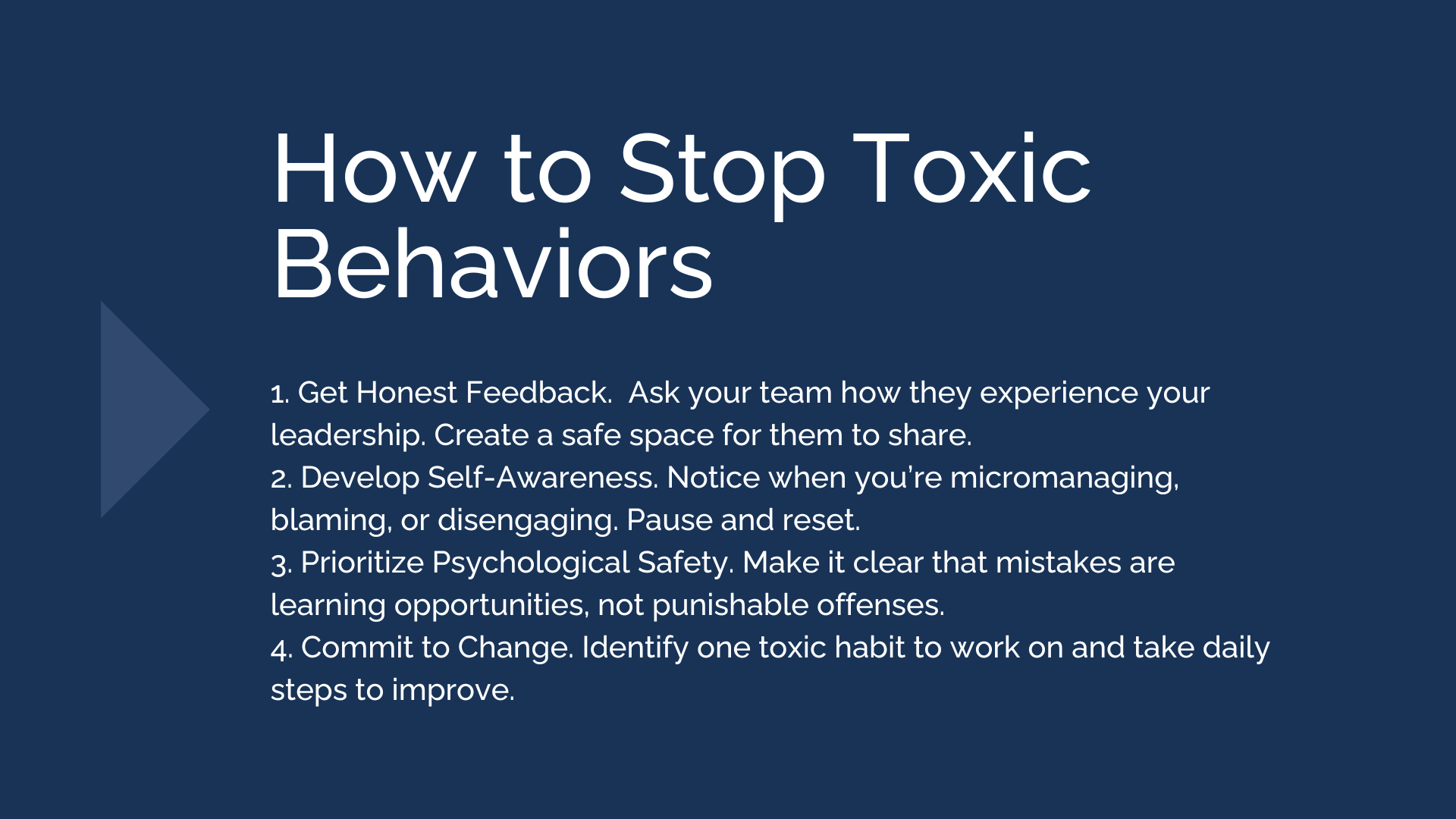
Final Thoughts
Building trust as a leader isn‘t about being perfect, its about being intentional. By fostering both vulnerability-based and operational-based trust, you create an environment where people feel safe, valued, and empowered. And when trust thrives, so does your team.
What’s one action you can take today to strengthen trust with your team?
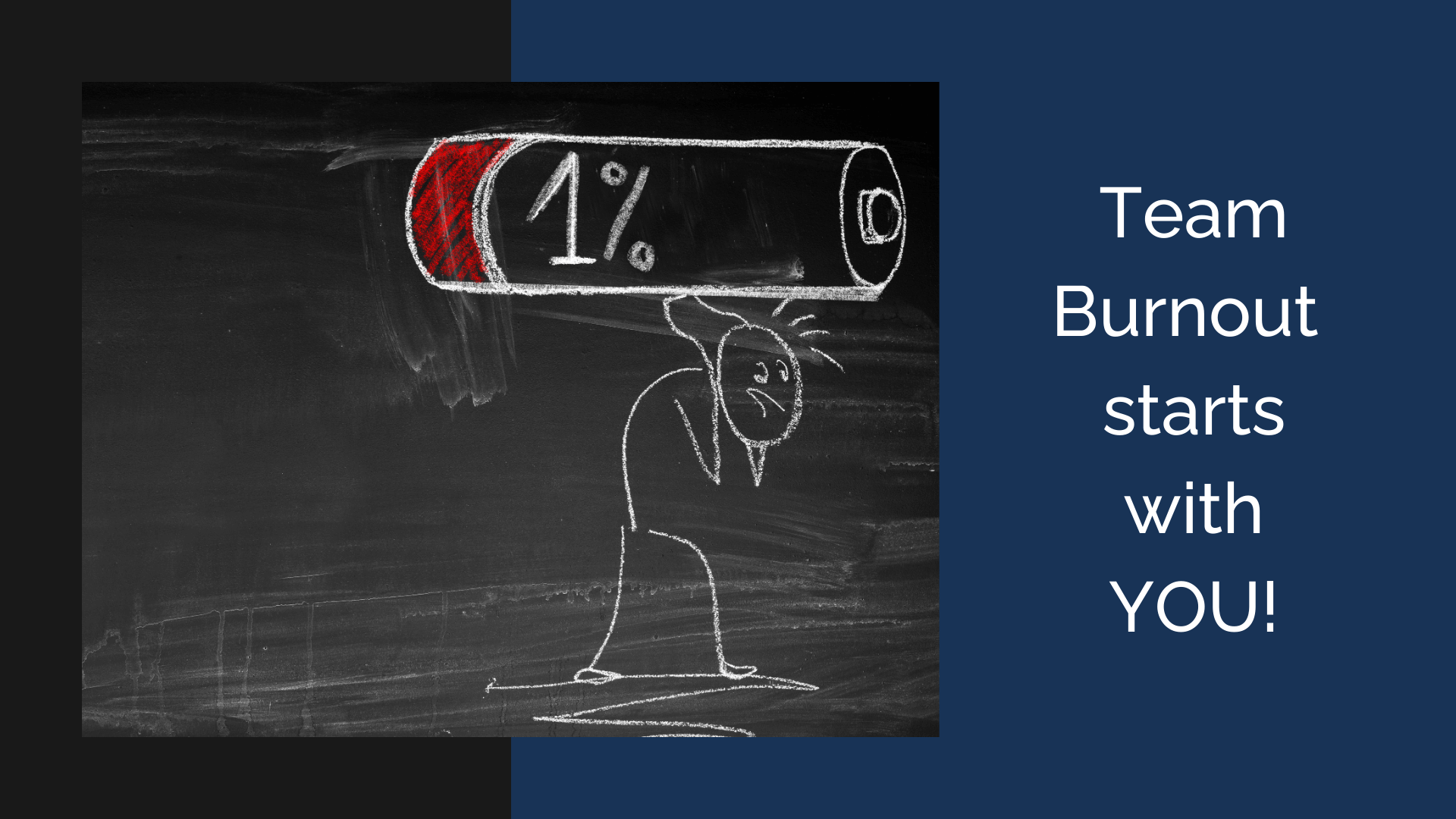
As leaders, we often find ourselves in high-stakes, high-pressure environments; depending on the organisation it might be product launches, tight deadlines, and the constant juggle between strategic goals and daily operations. It’s easy to get caught up in the whirlwind of demands, especially when the weight of your team’s success rests on your shoulders. Here's the truth: burnout isn’t a badge of honor. It’s a dangerous trap that can jeopardize not only your well-being but also your team’s performance and, ultimately, your organisation’s success.
I’ve been there. When I worked in the US, I found myself in an organization that didn’t respect boundaries. It was common for colleagues and leadership to reach out at 6 AM on a Sunday morning, expecting answers before breakfast. It wasn’t a one-time thing—it was the norm every single week. This kind of unsustainable culture highlights the poor leadership at the top, while at the same time, reflects on the poor processes established within the organisation; ones that didn't not allow for scale and automation, without any issues. This type of organisation doesn’t just hurt individuals; it harms entire teams and eventually the organizations itself. It really is extortion at it's best, in the sense, that if you don't align to this lack of boundary, your livelihood will be put on the line.
So, how do we avoid this toxic cycle of burnout and set boundaries that foster healthier, high-performing environments? Especially with organisations, or leaders that don't care?
Let’s dive in.
Why Burnout is a Leadership Issue
At the top, burnout starts and ends with the leader! When leaders normalize the hustle, overwork, and stress; when we don’t model self-care or set clear expectations, it trickles down through the organization, affecting the entire team. The team will be on tenterhooks, always looking out for emails that come through, at ridiculous hours and then snap to attention to get those replied to. It is an unrealistic expectation of leaders to have answers immediately after hours. In Australia they just laid down a law, saying that employers cannot reach out to employees after hours expecting them to do work. It is time that there was a paradigm shift, that we as leaders start to work on becoming conscious leaders, that think about the impact they have on others, to think about the opportunities to support and coach of the whole human being, that brings their inner life to work. We need to step up and move beyond transactional leadership, where we focus only on the deliverables and instead step into transformational leadership.
Often, leaders are not thinking about the downstream impacts. They might be only thinking to get something out of their heads and get their to do lists done. However, for the individuals on their teams, that is NOT how it lands, it lands as a command and to get that done now; no matter the time.
I’ve personally experienced firsthand how damaging this can be. The unwritten rules in organizations that call you at the crack of dawn, push deadlines without compassion, and expect your team to be on 24/7—these practices don’t just lead to burnout. They build resentment, discontent, and poor morale, along with high turnover and gossip culture. None of these are a good for any organisation or leader as it damages the reputation of both.
Here’s why it all begins with leadership:
You Set the Tone
As a leader, your behavior shapes the culture. If you’re constantly overworking, sending late-night emails, or pushing your team beyond reasonable limits, you’re sending a message that this is what’s expected. You create a “culture of busyness” rather than one of balanced productivity. Learn to prioritise. Prioritise your strategic goals, prioritise your initiatives that deliver on those goals, prioritise your to do list, prioritise your day. If you try to do everything, then NOTHING is a priority and you will burn out and burn out your team.
You want to be leading by example as burnout doesn’t happen in isolation; it’s contagious and you are role modelling it. When your team sees you working non-stop, they’ll do the same. You become a model for them, whether or not that’s your intention. Great leaders don’t just give orders; they live the culture they want to create by setting that example with their teams, by establishing boundaries, by focusing on established priorities and nothing else.
Long-Term Consequences
Even if your team pushes through burnout for a while, the long-term effects are devastating. Over time, stress accumulates, leading to decreased performance, lack of engagement, and eventual turnover. When a team is running on fumes, there’s no way they can bring their best work to the table. Physiologically, you are not connecting with the higher reasoning brain when stressed, so creativity and innovation are diminished greatly. If you as a leader are working 24/7, it is time to look into why. What are you running away from and avoiding, why is there no balance in your life? Where are there no priorities established? How can you better prioritise and setup boundaries? What processes are broken that cause noise every single week and need to be overhauled, to reduce the impact?
The Power of Setting Boundaries
Boundaries aren’t just about saying “no”—they’re about creating a sustainable work environment where people can give their best without sacrificing their personal lives. As a leader, it’s your responsibility to model and enforce boundaries that prioritize well-being and productivity. It's also your responsibility to establish priorities for the team and for the individuals on that team. There will always be too much to do constrained by limited capacity, regardless of the organisation. At Netflix we had a lot of money and engineers at the time Originals were growing exponentially. We all wanted to get cool innovative things done and we were also limited by the capacity of the engineers, regardless of the fact we had a lot of engineers.
🔹 Action Tip: Practice ruthless prioritisation as you will always reach a capacity limitation and you have to learn to manage within it. You need to focus your team on the things that are essential to deliver on the vision & strategic goals. That is it, everything else should be cut.
As a leader, you have to protect your time and your team’s time. I learned the hard way that working in an environment where boundaries are ignored isn’t just unhealthy; it’s counterproductive. When you constantly allow work to bleed into personal time, you burn out; not just as a leader, but also as a team. Boundaries ensure that everyone has time to recharge and return to work with fresh perspectives and renewed energy. Boundaries are also established through prioritising the work that matters. It is not realistic to expect everyone to get everything done all at once. It creates undue stress and pressure across many teams. You have to make progress towards something, chip away at the big things and give kudos when those little things are done, moving the team along towards the bigger things.
🔹 Action Tip: As a leader, schedule “off” times where you don’t check emails or take calls. Respect your team’s personal time—don’t set the expectation that they should be available outside of office hours. Use tools to manage how you work, without impacting your team. If you like doing emails at night, then by all means do them, but schedule their release for the morning, instead of that night.
As a leader you want to be setting clear expectations. Being a strong leader isn’t about having all the answers; it's about setting expectations. Set clear guidelines for when communication should occur, In fact, as a team, you can create "About Me" pages that outline who you are, what you work on, how you like to communicate, what channels you use most of the time and when the best time is to contact you. Work on communication agreements as a team that outline things such as; how urgent requests should be handled, who might be on call if needed and when people are expected to step away. Empathy is key. Understand that everyone has commitments outside of work, and these should be respected. They have families, young kids, side gigs, friends, social events.
🔹 Action Tip: Communicate the importance of work-life balance within your team. Encourage them to set boundaries and honor those limits, both for themselves and others. Establish team agreements that you all align to and create "About Me" pages that outline personal quirks
Why Teams Need breaks
As a leader, one of the most powerful things you can do is give your team the time they need to recharge. Time off isn’t just about vacations or weekends—it’s about creating space for your team to step away from the grind and come back with renewed creativity and focus. This includes managing calendars as a team, making sure that you have focus time of 3-4 hour blocks to work on things such as coding, design, discovery, research. Remember, you want to identify who is on a managers schedule versus a makers schedule. Those that are on managers schedules work in 30-60 minute blocks of time and the meeting is the work, while those on maker's schedules need long periods of time to create something. So make sure you manage calendars together and block out those focus time blocks. If you are on a manager's schedule you can book over the top of these as needed.
The Downstream Effects
When leaders fail to set boundaries and push their teams beyond their limits, the downstream effects can be catastrophic.
- Reduced Engagement and Motivation: People who are burned out don’t perform well, and they also don’t care as much about the organization’s goals. Their motivation dips, and their engagement drops. The result? Disengaged teams lead to higher turnover rates, lower job satisfaction, and ultimately, poorer outcomes.
- High Turnover and Loss of Talent: Overloading your team isn’t just a short-term problem—it leads to long-term consequences. People will leave when they’re consistently overloaded. A high-performing team needs space to breathe, or they’ll take their talent elsewhere. That talent costs you both in terms of recruitment and lost knowledge.
- Reputation Damage: As a leader, your actions reflect on the entire organization. If your team is burned out and morale is low, it can damage the company’s reputation—internally and externally. You’ll start losing talented professionals, struggling to attract top talent, and ultimately risk the organization’s success and sustainability.
Tools to help
Leaders can use a combination of email delay tools, collaboration tools, and management techniques to prevent burnout in their teams. Here are some effective tools and strategies:
How to Lead with Balance
It’s time to take control of your well-being and that of your team. Here’s how:
- Set boundaries that respect time off for both you and your team. Manage calendars together to include a makers schedule or no meeting days! Rest is needed for high performance to be achieved.
- Establish Priorities: Focus the team on things that matter and de-prioritize everything else.
- Encourage open communication—let your team know they can speak up about burnout or workload concerns.
- Model healthy work life boundaries—show your team that it’s okay to step back and take breaks and avoid sending late night emails.
- Focus on Outcomes rather than Hours: Results over time moving the dial on customer outcomes that matter
By setting healthy boundaries, you not only avoid burnout for yourself but also create an environment where your team can thrive, recharge, and bring their best work to the table.
One final note, so what if you work for an organisation or leader who just doesn't care? Well, for me, there is a value disconnect present here. The organisation or leader doesn't line up with your set of values and it is probably time for you to reflect on that and why you are wasting time in an organisation such as that. There are always options, even in tough markets right now and the question then becomes, what are you prepared to do, to work in an environment you enjoy. How long will it take for you to find that and how committed are you to doing so? Often, we just put up with the status quo and make half hearted attempts to change things, so take the time to reflect about what is important to you.
Your Turn: Have you ever experienced burnout as a leader? How do you manage the pressures of high-stakes environments while maintaining your own well-being and that of your team? Share your thoughts below!
As you know, I write a lot about the soft skills of leadership, as they are often not prioritized by those of us in leadership positions. While there is plenty of information available on topics like roadmaps, prioritization, and frameworks, there is far less focus on the softer, yet equally critical aspects of leadership; building performance cultures, doing shadow work, influencing others, and nurturing stakeholder relationships.
Relationships are the critical backbone of great leadership; certainly at Netflix, we spent all our time building relationships over time. Skillful relationship-building goes beyond transactional interactions; it enables us to unlock the best in others. As leaders, coaching the whole person and fostering genuine connections are essential skills that enable leaders to truly excel. At the same time, we must address emotional, conflict, and political challenges within our teams, navigating these situations with empathy and effectiveness.
Mastering the Conversations That Matter
As a leader, you are often called to engage in challenging conversations. These include situations where you need to:
- Share feedback with a colleague
- Influence decisions and direction
- Push back on direction
- Give a performance review to a direct report
- Manage conflicts and differing opinions
- Say no to senior executives
- Navigate individuals' emotional states
- Deal with your own triggers, biases, and emotions
Each of these scenarios requires conversations that are not just transactional but transformational. Such conversations build deeper relationships and amplify your leadership impact. They often involve opposing opinions, strong emotions, and high stakes, as described in Crucial Conversations (Patterson et al., 2021). Leaders who master these interactions; balancing the ability to get things done with the ability to nurture relationships, are the ones who thrive, but you have to be willing to have them. You cannot avoid them if you want to succeed and grow. It took me a long time to learn this, even though I had done the crucial conversations course with a Harvard lecturer, I still didn't get it, until I was at Netflix. There, there is no avoiding things like that, so you put the theory into action. Certainly a book worth reading.
Navigating Influence Without Direct Authority
As a leader, you may not always have direct authority; instead, your influence becomes your most potent tool. You’ll often find yourself in situations where you need to steer decisions without formal power. For example, when senior leaders with authority present a direction you disagree with, you might feel forced to either oppose them or stay silent.
But there is a third path; engaging in dialogue and debate. At Netflix, debate was embraced as a cornerstone of decision-making. A high-performing team is not afraid of conflict (The Five Dysfunctions of a Team, Lencioni, 2002). Debate enables teams to evaluate diverse perspectives, understand different datasets, and challenge assumptions, ultimately leading to well-informed decisions. This process, described as the free flow of meaning, requires open and honest sharing of opinions, feelings, assumptions and theories. If you have a team that is all being nice to each other; then I can show you a low performing team. High performing teams are respectful but say what needs to be said and they express their opinions openly and back it up with data. Debate is critical for good decision making.
The Ladder of Inference
The Ladder of Inference, introduced by psychologist Chris Argyris in 1970, is a powerful model that illustrates how individuals process data to make decisions. Each of us ascends this “ladder” based on selected data, beliefs, and assumptions. To foster understanding, leaders must climb up and down the ladder’s rungs by asking questions about others’ thought processes and exploring how they arrived at their conclusions. This approach fosters a shared dataset and mutual understanding.
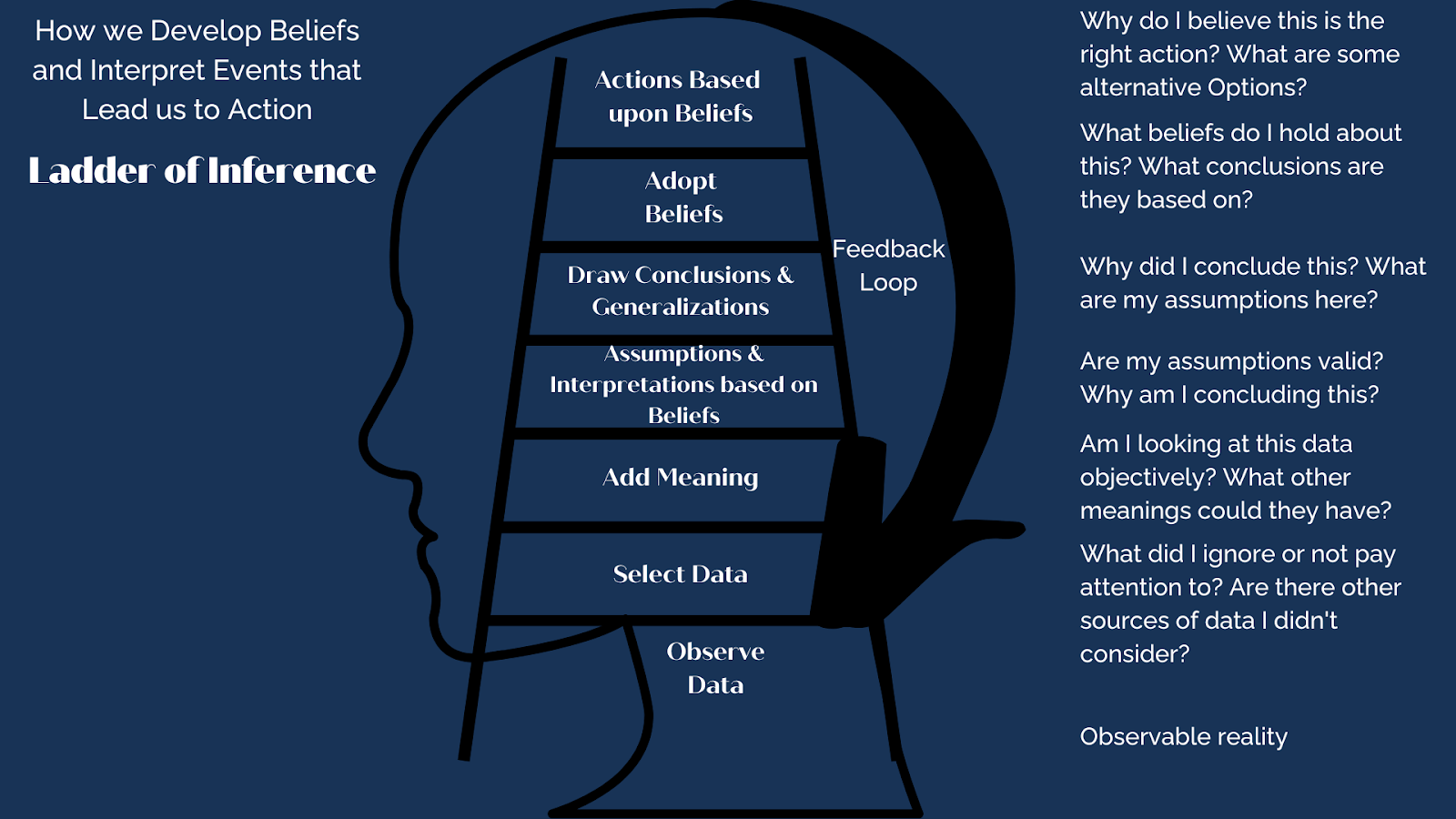
Establishing Psychological Safety
To facilitate open dialogue and healthy debate, leaders must establish psychological safety within their teams. Psychological safety; a culture where individuals feel secure to express ideas without fear of reprisal, is foundational for fostering trust and collaboration.
Remember, psychological safety is composed of two key elements:
- Vulnerability-based trust: This involves admitting mistakes, acknowledging uncertainty, and being authentic. When leaders demonstrate vulnerability, they set a powerful example for others to follow.
- Operational-based trust: This is built through identifying clear expectations and agreements as a team. Align on shared behaviors and values, document them, and hold each other accountable to them. At Netflix, this was our culture doc, in some companies it could be your team agreements.
Managing Your Triggers and Emotional States
To lead these conversations effectively, you must manage your own emotions and triggers. Shadow work; exploring your unconscious patterns and beliefs, is essential here. I often refer to them as our GRAILS: Gremlins (shadow identities, or imposter syndrome), rigid rules, assumptions, interpretations, limiting beliefs, and stories. These internal narratives can derail us if left unchecked, pushing us into reactive or unproductive states. If you have not done the work to identify these, lovingly accept & integrate these, then you will always be triggered & judgemental of others. Often because you yourself exhibit those very same traits. So stand tall, do the work, identify your shadow, don't make yourself wrong for these, as you too are human and then just notice and accept. There is nothing wrong to be human.
Ask yourself reflective questions: What beliefs are driving your reaction? Where did they stem from? What assumptions are you making? What alternative interpretations could you come up with? How can you reframe? Where do I exhibit this trait? What can I learn? By unpacking these elements, you connect with your authentic self, reducing emotional reactivity and strengthening your relationships.
Speaking Your Truth with Integrity
Integrity demands that you speak your truth. If you disagree with a decision or want to pursue a promotion, voice it clearly and logically, supported by data. Avoid operating from a place of emotional reactivity or personal attacks. Instead, frame your feedback to empower and inspire others. Tools like the SBI framework (Situation, Behavior, Impact) can help structure your message effectively and keep it objective. Remember, to operate with integrity you should honour your words, speak your truth, feel your feelings and handle your responsibilities without taking on others. So speak and SHARE your truth through respectful and empowering feedback that is clear, direct, objective and doesn't finger point. Take on your part of the situation; what did you do to contribute to that and what can you do differently.
Separating Facts from Stories
More often than not, we conflate facts with the stories we tell ourselves about those facts and that becomes our truth. For example, if a colleague doesn’t immediately support the direction you want to take, you might interpret this as “they don’t respect my ideas.” But is that fact or story? Separating the two is essential for clarity and effective action. You sharing the direction is fact, the interpretation of "they don't respect my ideas" is not, that is your assumption & interpretation of their response. What are some alternative assumptions & interpretations you can take? Choose something more empowering to you always!
Escaping the Drama Triangle
Stephen Karpman’s Drama Triangle outlines three dysfunctional roles: the Victim, the Villain, and the Hero. People can shift between these roles in different situations, and the cycle can be difficult to escape. Understanding the drama triangle can help identify behavioral patterns in yourself and your teams and the key is to be able to identify them. These roles perpetuate unhealthy dynamics and can impede productive conversations.
There are three damaging stories we tell ourselves
- Victim stories: these are where we believe that the other person has made us the victim of their actions, or we have no ability to succeed or do, given the situation and it absolves our responsibility.
- Villain stories: these are where we believe that others have bad intentions and succeeded in ruining something for you.
- Hero stories: these are where we play the martyr and believe we do everything and have too much to do and no one else works as hard as we do, or we are rescuing others, so we have to do their work, but in reality, this disempowers others, keeps them dependent and creates blockers, the main one being you.
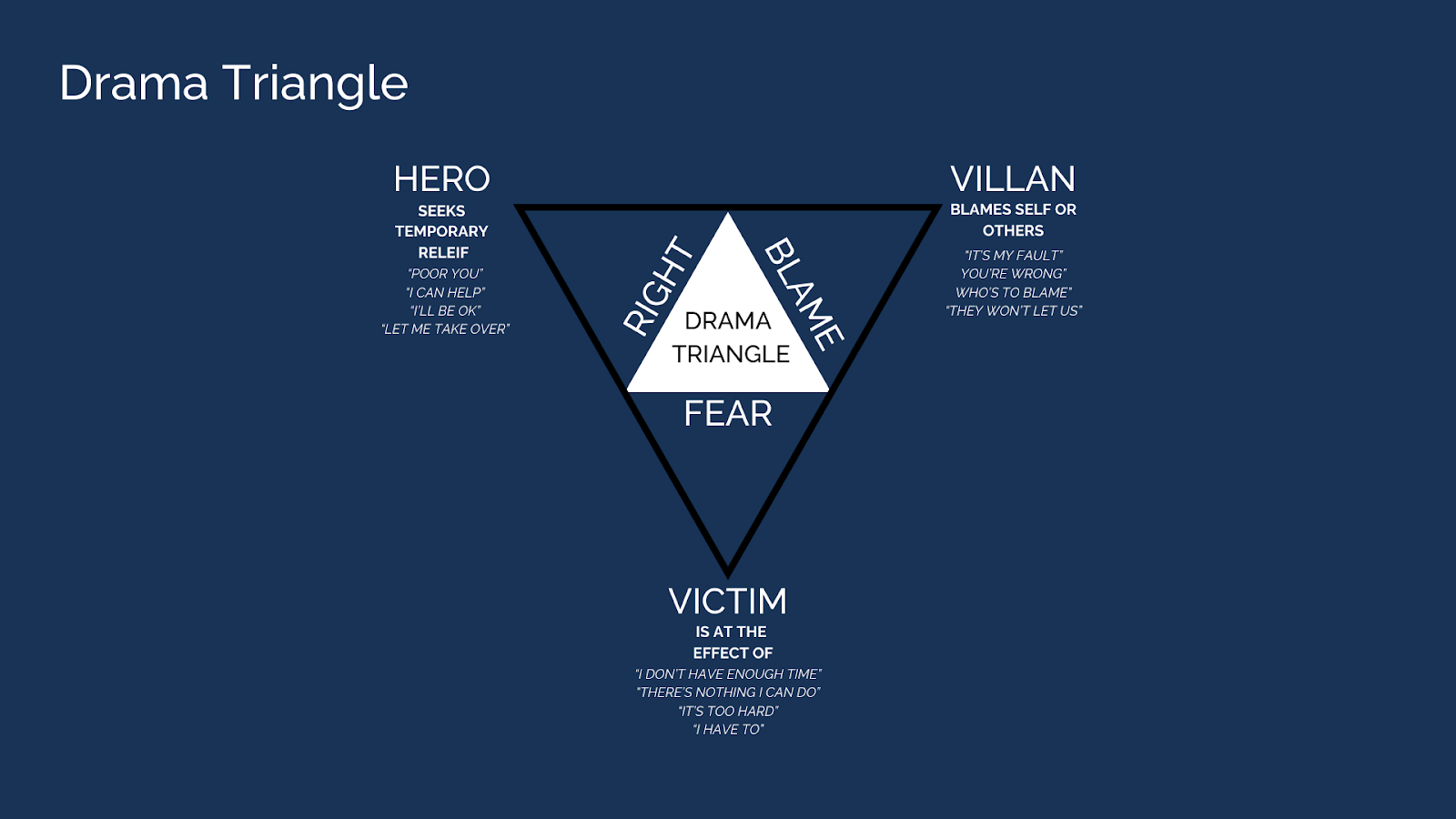
To get out of the drama triangle you will need to firstly become self aware. Ask yourself a few powerful questions to improve your self-awareness. Self-awareness is the first step to breaking free. Consider:
- What role are you playing?
- How does it serve or hinder you?
- What actions can you take to shift the dynamic?
Your next step is to take action and implement desired changes. Making and sustaining change can be challenging, as you are moving out from your ‘comfort zone’. It’s helpful to have a coach, manager, or trusted colleague, who can be objective about this, help you to see when you are being one or more of those three roles and in what situations and then support you through the change process. Remember to choose to have empowering conversations, rather than conversations of blame and finger pointing; take responsibility for YOUR part in any situation, rather than look to blame. How did you contribute to the situation and what did you do to create it?
David Emerald Womeldorff’s Empowerment Dynamic (TED) provides an alternative framework that will allow you to shift from Victim to Creator; taking responsibility for your choices and actions, Rescuer to Coach; empowering others to find their solutions. and Persecutor to Challenger; offering constructive feedback that fosters growth. These empowered roles foster growth, collaboration, mindset change, working towards desired outcomes, generating greater awareness and more options. Remember to always be respectful and work towards establishing mutual goals. You can only do that in dialogue and through debate.
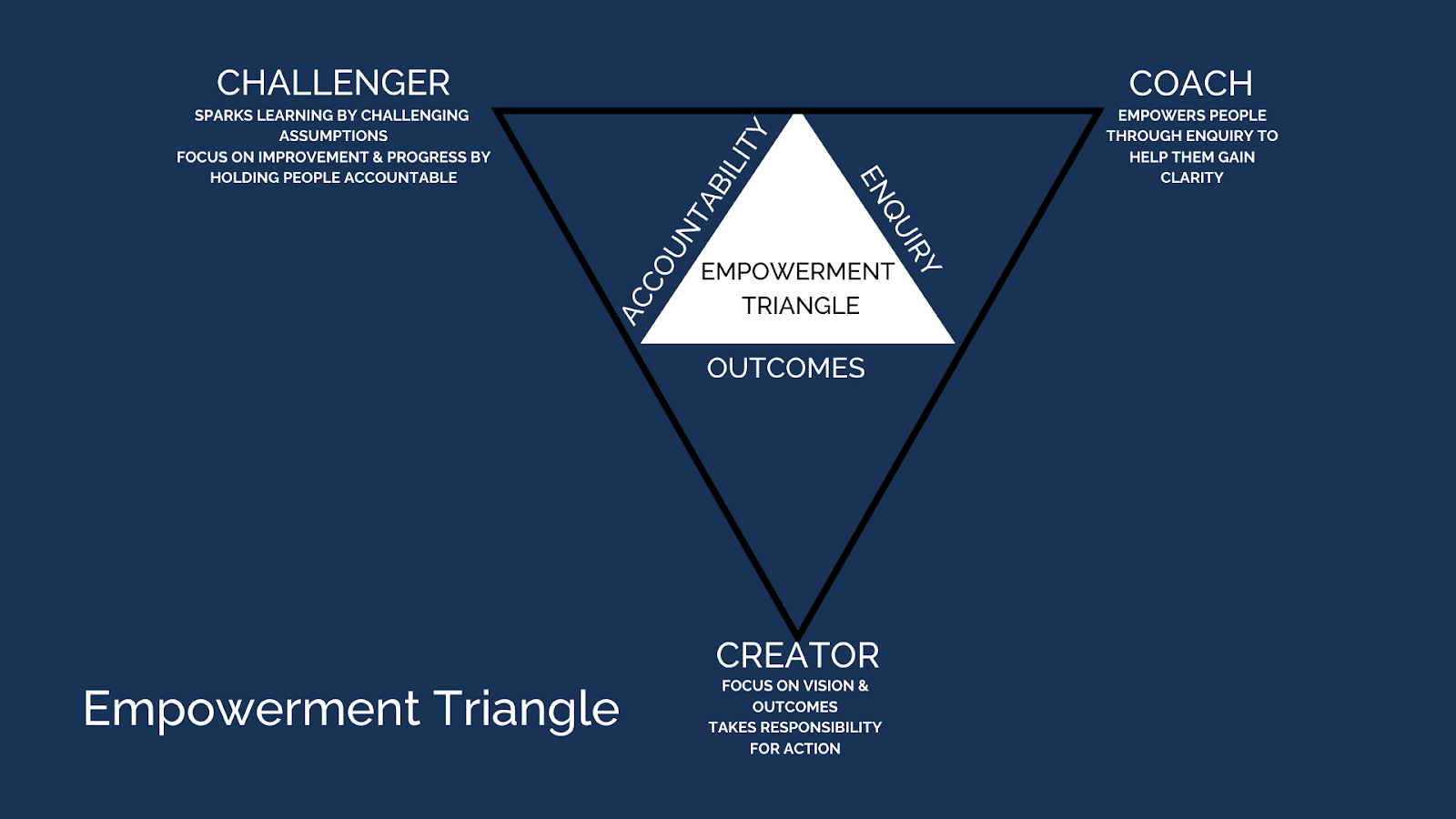
Building Alignment Through Vision and Strategy
Vision and strategy provide the context for all other conversations. Co-creating these elements with your team through workshops fosters alignment and buy-in, minimizing future misunderstandings. A shared vision becomes a mutual purpose that guides priorities and decision-making.
Patience and Practice
Leadership is a journey. Be patient with yourself and others. Allow space for emotions and processing, especially when delivering feedback. With consistent practice, you will develop the conversational skills necessary to influence, inspire, and lead with impact.vBy mastering these elements of psychological safety, emotional management, clear communication, and a commitment to authenticity, you will elevate your leadership and cultivate meaningful relationships that drive success.
Actionable Items to consider
- Observe Your Conversations: For the next week, pay attention to your conversations. Notice how much time you spend listening versus talking. Are you truly present? Are you playing victim, villain or hero in any of those conversations? If so, which ones and consider shifting to coach, challenger, creator.
- Practice Active Listening: During your next team meeting, focus on active listening. Reflect back what you hear and ensure you understand the other person’s perspective before responding.
- Experiment with Open-Ended Questions: Prepare a list of open-ended questions to use in your next conversation, such as, “What do you think we should prioritize?” or “How do you feel about this direction?” What data are you looking at? How did you arrive at that conclusion?
- Adapt Your Energy: Before entering a conversation, take a moment to assess your energy. Ask yourself, “Am I bringing a calm and curious presence, or am I rushing in with assumptions?” "Am I triggered and if so, why"
- Seek Feedback: Ask a trusted colleague or team member to observe your conversational style. Request feedback on how your approach impacts others.
- Identify Your Communication Patterns: Reflect on whether you tend to persuade, argue, or influence. Practice influencing by aligning your words with shared goals or values rather than relying on authority.
- Align Conversations with Vision: Take time to connect team discussions to the broader vision or shared goals. Frame conversations to inspire collaboration toward a common outcome.
If you want to take yourself on this year in order to get to the next level; reach out, book some coaching, have a conversation and step it up!
I hope you're all finding some time to relax and enjoy yourselves!
As we approach the tail end of 2024, I find myself reflecting on the past 12 months in order to think about and create my vision and goals for the next 12 months. This is a regular activity I do each year and it allows me to really think through what is important to me, what I actually achieved the year before and am proud of, as well as what I want to achieve in the next year.
As you have read in my past blogs, success is all about taking continual action in line with your vision,. The vision clearly establishes a stake in the ground you are aiming for, while your goals deliver on your vision. It is equally important to write all of this down. Why? Well, I think I have mentioned the 1953 Harvard study that asked students about their goals and they found the following:
- 3% said they had clear, written goals.
- 13% had goals, just not written down.
- 84% did not have goals at all.
Ten years later, it was discovered that the 13% who had not written down goals earned on average twice as much as the 84% who did not have any goals at all. The 3% who had written goals outperformed everyone altogether by earning ten times as much as all of the other 97% combined.
This highlights to me that success is a systematic, continual process that you chip away at by following clear steps, adapting to whatever challenges arise when they arise, and consistently executing. Making progress, rather than aiming for perfection!
So, as you face seeing the New Year in, rather than making New Year’s resolutions in the spur and excitement of the moment; take the time NOW, today to write down your vision and goals, identify the big why, why its important to you and then break those goals down into small steps you can take over the next 3 months. Then every 3 months, break down the next goal and the next, making it more achievable.
Everything Starts with a Vision!
It doesn’t matter if it is a personal vision, a business vision or a product vision, it all starts with a vision and a vision brings clarity. A vision should align with your higher values and your actions and words should align with both. Make sure to identify your “big enough reason why”. What is behind why you want to achieve something. If the reason is big enough, this will be your driving motivation; it will pull you forward every-time you want to give up. Incorporate that into your vision. Make sure to write this all down and print it out so you can re-read it often. I have also incorporated images into my vision document as the brain loves images; so I make sure to write it down, have visuals and also read it out loud to myself regularly. I believe this is why I have never not achieved what I have aimed for. This practice is routine for me.
Practical Steps:
- Write down your vision. What is it you are out to create for yourself, your life, your team, your organisation. Where do you see yourself in 2 years time. What is that picture of the future.
- Now looking back from that future to today, what are the top 3-5 goals you took
- Prioritize these for 2025 by asking yourself why are these important?
- Make your goals SMART (Specific, Measurable, Achievable, Relevant, Time-bound), this will ensure focus and a sense of achievement as you will know what success looks like.
Take Action Now!
Visions, or Resolutions mean nothing without action! Don’t wait for perfect conditions, when everything is right, when you have all the equipment, when you have finished the script, the taxonomy, the team, setup the business. Instead start now, immediately, create a version 1,, or 1 module, or a blog and then learn, and adapt along the way. As you learn, you will get better, you will iterate and recalibrate and create a version 2 that builds on version 1. Take action immediately, no matter how small and take it continually, a 1% improvement each day adds up to a whopping 38% difference in a year. Those incremental changes build up.
Practical Steps:
- Break down your goals into small, actionable steps.
- What is one action you can do or take today that will make a difference towards your goals, no matter how small and focus on 1% change.
- Celebrate the progress you make; stop to look back and see how far you have come. Don’t wait for perfection. I like to keep a running list of achievements handy for me to read and remember.
- You can attach dates to action items; not something I do in fine detail, but I do attach quarters and years, rather than specific dates.
Mindset is Everything!
Successful people cultivate a growth mindset that is positive, optimistic and motivated, which inspires others, as positive energy is contagious and helps to achieve great things. This is highlighted through the research from Stanford academics Dr. Carol Dweck and Dr. Alia Crum highlighting how mindset fundamentally shapes success, achievement, and the ability to change one’s life. Both scholars demonstrate that mindset is not merely a belief system but a framework that influences behavior, resilience, and physiological responses to challenges. Here’s why mindset is so impactful:
Dr Carol Dweck’s seminal work focuses on the difference between a growth mindset (belief that abilities and intelligence can develop through effort and learning) and a fixed mindset (belief that these traits are innate and unchangeable). She determined that a growth mindset leads individuals to embrace challenges, persist through setbacks, and view failure as an opportunity for learning. In contrast, a fixed mindset can lead to fear of failure, avoidance of effort, and stagnation.
Dr. Alia Crum’s research on the stress-is-enhancing mindset shows that how you perceive stress can directly influence your physiological and emotional responses. Viewing stress as a challenge rather than a threat improves performance, enhances well-being, and reduces negative health outcomes. In essence, those with a positive stress mindset are more likely to channel stress into motivation, creativity, and growth, while a negative mindset can trigger harmful physical responses like chronic inflammation and burnout.
Both Dweck and Crum demonstrate that beliefs shape behaviors and outcomes. For example, believing that effort leads to improvement (Dweck) or that stress is beneficial (Crum) motivates individuals to act in ways that reinforce those beliefs. This can create a virtuous cycle of effort, learning, and success. Conversely, negative beliefs can lead to self-sabotage and missed opportunities.
Dweck’s research shows that a growth mindset encourages intrinsic motivation; the drive to learn and improve for its own sake. This kind of motivation leads to higher achievement and sustained effort, even in the face of difficulty. Crum’s studies on the placebo effect and mindset also demonstrate how beliefs about health, nutrition, or stress can significantly influence actual physical outcomes. For instance, believing that exercise is beneficial amplifies its physiological benefits.
A growth mindset allows people to view change as an opportunity for development rather than a threat. This adaptability is essential for navigating life’s inevitable transitions. Crum’s work emphasizes the transformative power of reframing perceptions, showing that shifting how you think about challenges can fundamentally change how you experience and respond to them.
Practical Steps:
- Practice gratitude and identify 5 things a day you are grateful for
- Keep a running list of achievements so you can celebrate what you have achieved
- Keep a folder of kudos whenever someone recognizes your work, so you can read it whenever you need to and remind yourself of a job well done
- Identify limiting beliefs and work to reframe them, understanding that they are all decisions you made when you were young and most likely are not real; they only exist in language and hence are conceptual
- Communicate in a way that contributes to others, that is uplifting and is empowering, even when it is constructive feedback; think about how to leave the other person feeling empowered to take action.
- Always reflect on the past; what could you do better? How can you be a better person? What did you learn and how will you change as a result? What can you do differently? How can you improve? How can you learn more? Who can you learn from?
- Have an empowering conversation for yourself about yourself! Be your own best cheerleader and catch your thoughts when they turn negative; always canceling and reframing to an empowering thought. YOU are in charge of your thinking, not anyone else, not your past, not your parents, YOU! You are responsible for your life and your thoughts! So take them in hand and manage them.
Always Be Prepared!
Visions and goals are fun, but life happens, and challenges arise, hence, you should work to anticipate potential challenges and prepare for them before they derail progress. Identifying those risks are a great practice. What are those things that could pull you in a hundred different ways?
Practical Steps:
- What internal dialogues could stop you?
- What obligations could derail you? Study, family, organizational & structural blockers and how can you work to get around these? Are there support systems or buddies you can establish or work with to keep you accountable? This is why working with a coach is so great and helps people achieve big things, because of the accountability structure it creates.
- Are you ready for disruptive market trends? What about any new technology that is coming? Are you aware of those 3 horizons? What about industry or community trends? How will those change things for you?
- What key relationships do you not have and you need to establish?
- Where can you prioritize more effectively?
- If you are stopped or blocked, what can you do to change that? Is there a lesson to learn here? How can you reframe this as an opportunity? What can you leverage?
Progress is Key!
Momentum sustains action and builds towards success. It is a positive feedback loop. The more you achieve, the more you do. Have you ever noticed when you have nothing much to do, you do nothing much? Whereas when you are incredibly busy, you achieve huge amounts? Busy people achieve a lot and they build it through small sustainable actions, that builds progress towards their vision..
Practical Steps:
- Check-in weekly with others to discuss, be accountable and realign priorities. I have a daily “Create Your Day” practice with others where we share our visions and action items, that then keeps us accountable. Who are those people for you? Do you have a coach that is that for you?
- Lean into guidance from mentors, coaches, other leaders, as there is ALWAYS something to learn from someone. A full glass can never take on more water (or wine for that matter), so always come at everything with “beginners mind” be curious and look for the gold dropping from peoples mouths, as you will always learn something.
- After every goal you achieve, ask: What worked? What didn’t? What did we learn? What will we do differently as a result? How did you grow as a person? What was missing? What more could you have done? Where were you not in integrity?
As James Clear states, consistent progress, in small increments, quickly compounds over time, 1% change becomes nearly 38% change in a year. Success isn’t about setting resolutions on New Year’s Eve and then doing that thing for 5 weeks and then forgetting about it.. It’s about taking small consistent actions, towards your vision and goals, that help you execute incrementally and learn.
Transformative Visions wishes you all a happy holiday season and here’s to a new year of extraordinary growth! Whatever that looks like for YOU!
Ready to create a powerful vision and actionable goals for 2025? Join my coaching programs, courses, to gain the clarity, strategies, and accountability you need to transform your life and achieve extraordinary results. Start your journey today—your future self will thank you!

